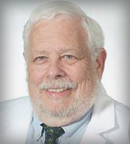More than 5 decades ago, the concept of bone marrow transplantation to treat humans with leukemia was met with varying degrees of skepticism and countless clinical failures. Yet, over those same decades, bone marrow transplantation was transformed from an insurmountable therapeutic option used in a limited and highly select number of patients to a standard-of-care therapy for about 50,000 patients worldwide.

Roger H. Herzig, MD
Transplant doctors are a special breed, as was Roger H. Herzig, MD, who spent nearly 50 years of medical practice touching countless lives of patients with hematologic cancers, educating several generations of physicians, and helping establish bone marrow transplant programs internationally. Dr. Herzig died on July 18, 2020, at the age of 74.
Following His Brother
Dr. Herzig was born on January 4, 1946, in Cleveland. He and his older brother, Geoffrey, also a noted transplant doctor, lived a peripatetic childhood, moving from his birthplace of Cleveland, to Cincinnati, and later to Georgia. Dr. Herzig, who showed an early aptitude for the sciences, was a graduate of Walnut Hills High School and then went on to the University of Cincinnati.
After receiving his undergraduate degree, he applied to medical school at Case Western Reserve University, Cleveland, where Geoffrey was attending. Dr. Herzig was fond of telling the story about his interview for admission. The school’s dean had his and his brother’s files on the desk when he suddenly cut the interview short, asking Dr. Herzig if he was as smart as Geoffrey, who was by then the brightest student in his class and a member of the medical honor society, Alpha Omega Alpha. Dr. Herzig quickly replied: “Not as smart, but a lot more normal.” He was accepted the following day.
Career Accelerates at the NIH
During the Vietnam War, the brightest young physicians inducted into the military under the Doctors Draft had the option to go the National Institutes of Health (NIH) in an Associate Training Program. Dr. Herzig was vetted to the Oncology Branch of the National Cancer Institute, not the National Institute of Child Health and Human Development. There, he worked with early leukemia and hematopoietic cell transplant innovators including Drs. Robert Graw Jr, Malcolm and Jane Bull, David Poplack, Brigid Leventhal, Ronald Yankee, Archie Bleyer, Edward Henderson, and Geoffrey, where he helped design therapies to treat people with leukemias and lymphomas.
After his service at the NIH, Dr. Herzig returned to Cleveland and became the founding Director of Bone Marrow Transplant Programs at University Hospital and the Cleveland Clinic, before moving to Louisville to serve as Director of the University of Louisville James Graham Brown Cancer Center in 1988. He contributed to research, education, and patient care through tenures at the University of Cincinnati and the University of Kentucky before returning to the University of Louisville in 2020.
A Man for All Seasons
Dr. Herzig’s long-time friend and collaborator, Robert Peter Gale MD, PhD, DSc (hc), FACP, FRCPI (hon), FRSM, said that if you knew Dr. Herzig, chances are you met him in one of two places: the hospital or the thoroughbred racetrack. He took his love of horse racing to heart so much that he was part owner of Northern Emerald, a thoroughbred that raced at Belmont Park. Along with racehorses, Dr. Herzig was an accomplished dog breeder; one of his champions won Best in Show at the Westminster Kennel Club Dog Show. He also had a cameo role in the TV show One Life to Live, during which he coined the phrase he loved to say: “I’m a doctor playing one.”
His eccentric avocations aside, as noted by his numerous friends and colleagues, Dr. Herzig was first and foremost a doctor dedicated to helping patients navigate through difficult cancer treatment. He spent endless hours at the hospital to be available for his patients and their families. His gentle nature and kind heart always meant his patients knew they had someone on their side.
A Workaholic by Desire
Over the course of his distinguished career, Dr. Herzig formed close collaborations for clinical trials with Drs. Geoff and Hillard Lazarus, Gordon Phillips, David Hurd, Steven Wolff, Joseph Fay, and others in the North American Marrow Transplant Group, a small but dynamic clinical trials consortium. Several of their outstanding contributions were studies of high-dose cytarabine for acute leukemia in relapse and later for consolidation, bone marrow autologous transplants for advanced lymphomas, and high-dose melphalan in hematopoietic cell transplants—therapies still in wide use today.
Dr. Herzig published more than 100 typescripts including 34 with Geoffrey. He was a member of many learned societies such as ASCO, the American Society of Hematology, and the International Society of Experimental Hematology, and was Honorary Professor of the Chinese Academy of Medical Sciences and Peking Union Medical College.
Jason Chesney, MD, Director of the Brown Cancer Center, said in a tribute: “Roger was exceptionally dedicated to his patients and saved the lives of thousands, a workaholic who always had to turn his headlights off when he arrived to work (even in the summertime), and an incredibly warm and genuine friend and colleague. I will miss him and know many others will too.”
Dr. Herzig is survived by his spouse of 53 years, Donna Stern Herzig; his four children, David, Daniel, Robert, and Brian; three daughters-in-law, Belinda, Sallie, and Emilie; and nine grandchildren.

